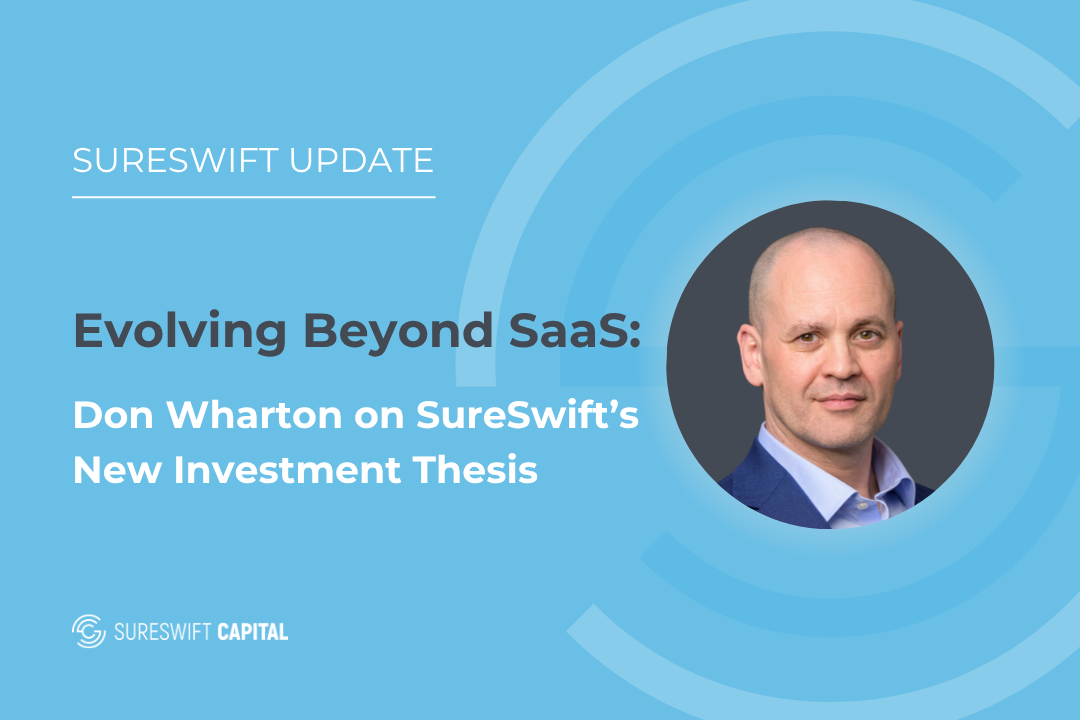Helping Legacy Businesses Grow Through Tech Enablement
.png)
Most local service businesses run on expertise, not systems. HVAC companies, fire inspection firms, electricians, and niche manufacturers know their craft inside out, but behind the scenes, jobs get tracked on whiteboards, invoices live in Word docs, and dispatch happens from memory.
These are the businesses that keep our communities running. They’re reliable and in demand, but often struggle to grow. Admin work piles up, customers fall through the cracks, and owners rarely have the time to step back and fix the bottlenecks.
That’s where SureSwift sees opportunity. After a decade operating SaaS companies, we know what scalable systems look like—and we’re bringing that playbook to essential, service-based businesses that are reliable, in-demand, and running below their tech potential.
Throughout this blog, you’ll hear from three of our leaders: Johnathan Crowe, Director of Technology & Services; James Addison, Chief Software Architect; and David Aidekman, General Manager of Docparser & Mailparser. They’re leading SureSwift’s charge into tech enablement, and what follows is how we’re putting these ideas into practice today.
Table of Contents
- From SaaS to service businesses: Our investment shift
- What tech enablement actually looks like
- Tech enablement: The new competitive edge in service industries
- How we support tech-enabled growth at SureSwift
- AI as a multiplier for service business growth
- Why tech multiplies value in service businesses
From SaaS to service businesses: Our investment shift

SaaS taught us how much impact the right systems can have. The same opportunity exists in service-based industries, where many businesses are still run by hands-on owners nearing retirement.
They deliver essential, recurring services like HVAC maintenance, fire inspections, or electrical repairs yet there’s plenty of room to improve how they operate. Addison explains it best: “Imagine a HVAC company with no CRM, no scheduling tool, and no automated payments. These are solvable gaps. And we know how to solve them.”
The goal isn’t to pile software onto messy operations. It’s to rethink the entire customer journey. “You know when someone last serviced their HVAC. You know when it’s due again. Automate the outreach, book the job, route the tech, invoice instantly. That’s tech enablement,” says Aidekman. Most of these businesses already have the patterns and know-how. What’s missing are the systems to turn that knowledge into something repeatable and scalable.
Crowe agrees: “A company doesn’t need to be digital-first to benefit from tech enablement. You just need recurring behaviours and pain points that are screaming for systems.”
That’s what our investment thesis unlocks. We’re bringing SureSwift’s experience in building systems and scalable operations into industries that have been overlooked. Many of these businesses serve thousands of customers without a CRM, scheduling tools, or automation. The gap between potential and performance is wide, and tech enablement is how you close it.
What tech enablement actually looks like

Tech enablement starts with understanding how work actually gets done. We map workflows, shadow technicians, talk with dispatchers, and unpack every manual process that drives value.
“Tech enablement is just modern operations,” says Crowe. “It’s understanding how value flows through the business, then asking where the slowdowns are. Where are we losing time? Where are we repeating things? Where is information getting dropped?”
From that discovery process, opportunities usually fall into a few buckets:
- Automating everyday tasks like quoting, scheduling, reminders, and invoicing
- Improving communication through confirmations, updates, and follow-ups
- Centralizing data so the ops team, technicians, and billing all share one record
- Reducing friction with faster quote turnaround or fewer dispatch delays
And these patterns repeat across every trade.
- In HVAC, service reminders and follow-ups can run automatically.
- In fire and life safety, inspection reports can sync instantly into customer records.
- In electrical, route optimization saves hours in drive time each week.
- In manufacturing, digital quoting and order tracking improve turnaround time and cash flow.
These fixes don’t have to be complex. “Start with what’s available off the shelf. Only build if the ROI is undeniable. Most of the lift comes from applying simple tools well,” says Addison.
Even small shifts can have a big impact. “Centralizing customer data into a shared CRM can be transformative,” adds Crowe. “Suddenly your ops team, techs, and billing crew are speaking the same language.”
That’s why we lean on proven tools like CRMs, scheduling tools, and communication automation. The tools themselves aren’t the point, it’s the systems they support and how well they’re adopted. When flow improves, the business doesn’t just run better—it becomes more valuable.
Tech enablement: The new competitive edge in service industries
Most service companies don’t lack demand. They lack efficiency. That’s where SureSwift finds margin.
With tech enablement, we help businesses:
- Shrink admin time by removing duplicate work
- Protect margins with better visibility into job profitability
- Speed up onboarding through clear SOPs and mobile tools
- Retain staff by cutting daily chaos and manual tracking
- Expand into new markets using repeatable playbooks
“Too often we see a company double revenue and just add more chaos,” says Crowe. “That’s not scale. That’s drag.”
Tech enablement does the opposite. A team that once needed two schedulers can run with one. Dispatching becomes smarter, quoting faster, and follow-ups automatic. Aidekman explains, “if you automate even one part of the process—dispatching, billing, or scheduling—you can 10x your output with the same team.”
The result isn’t just smoother operations. Customers feel it too. Automated reminders, clean estimates, and instant updates make the business feel more professional, which builds trust and repeat work.
“Tech makes businesses more legible. When you can see what’s working and what’s not, you can scale with confidence—or sell for a premium,” says Crowe.
In fragmented, compliance-heavy industries like fire safety and electrical, operational maturity becomes the moat. Predictable businesses aren’t just easier to run. They’re easier to finance, expand, and eventually transition.
How we support tech-enabled growth at SureSwift

We don’t just hand over a software stack and walk away. Our approach is hands-on. We work alongside teams to install, adopt, and refine systems that truly change how the business runs.
Addison describes our method as “a solutions team, not an engineering team.” That means starting with discovery, leaning on proven tools, and only building when the payoff is clear.
But tech alone doesn’t solve problems—people do. “Adoption is the hard part,” says Crowe. “Teams won’t change just because software gets installed. That’s why we spend as much time with people as we do with tools.”
We make adoption stick through live training, tailored documentation, real-time support, and post-mortems. If something doesn’t work, we adjust. If a workflow saves time, we scale it.
Inside SureSwift, we’ve seen this first-hand. Aidekman recalls, “We used automated personalized emails at scale to collect structured feedback. That data changed how we built and supported our products.” The tool itself wasn’t the win; it was the process of making data usable and actionable.
And while it’s tempting to overbuild, Addison reminds us to stay grounded: “The biggest pitfall is overengineering. Always ask: how can we do this in half the time or with twice the impact?”
That’s the difference between installing software and enabling a business.
AI as a multiplier for service business growth
AI isn’t a silver bullet, but applied well, it’s a force multiplier. It helps people move faster, make smarter decisions, and focus on the work that actually grows the business.
“AI can support every part of operations,” says Crowe. “Outreach, quoting, support, hiring — anything process-driven can eventually be automated.”
At SureSwift, we see AI driving change in three ways:
- Personal productivity: drafting quotes, summarizing meetings, or creating follow-ups.
- Internal automation: handling confirmations, reminders, and support tickets.
- Customer-facing tool: instant quoting, smart recommendations, or support triage.
Addison has been exploring what the next level might look like: “Picture an AI dispatcher that books jobs, assigns technicians based on skills and location, confirms with customers, and logs everything automatically. We’re not there yet, but we’re closer than people think.”
The promise of AI isn’t in replacing people, but in amplifying what businesses already do well. It turns repetitive work into reliable systems, freeing up time to focus on customers and strategy.
Why tech multiplies value in service businesses
Software doesn’t replace great businesses. It strengthens them.
We’ve seen small changes lead to big outcomes. From automating reminders to centralizing customer records, every improvement compounds over time. The result is faster, smoother operations and stronger business value.
Our edge comes from combining SaaS instincts with the realities of durable, service-based operations. We know where tech creates leverage, and we’ve built the internal muscle to execute, not just advise.
“If you’re an operator who knows your business works but feels like it’s being held back by the day-to-day, that’s where we come in,” says Crowe.
And for investors, the upside is just as clear. Operational maturity creates real, compounding value in industries where demand is steady but systems lag behind.
Great businesses deserve great systems. Learn more about how we work with entrepreneurs or contact us to start a conversation.
Related articles

Evolving Beyond SaaS: Don Wharton on SureSwift’s New Investment Thesis
After nearly a decade of success in SaaS, SureSwift is turning the page. Founder Don Wharton shares why the company’s next phase focuses on acquiring and tech-enabling durable service businesses built for resilience and growth.

My SureSwift Internship Wasn’t What I Expected
SureSwift’s internship program doesn’t follow the usual script. Lucas Quon joined as a co-op student and quickly found himself doing real M&A work. He was trusted to dive in, ask questions, and contribute in a meaningful way that made the whole experience more impactful than he expected.

